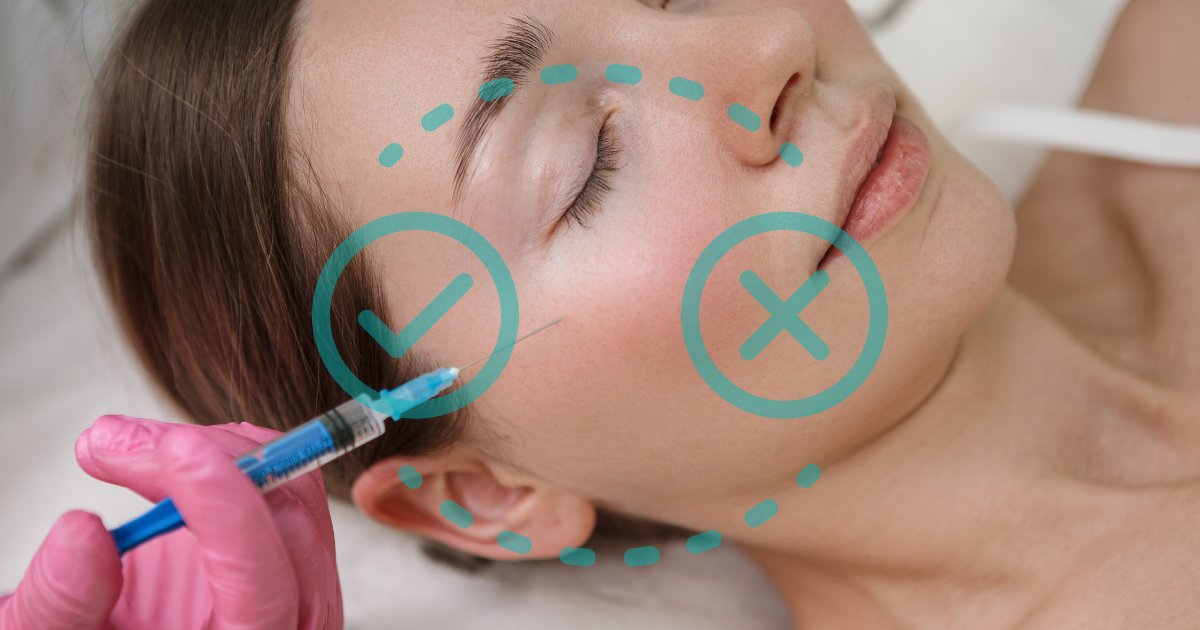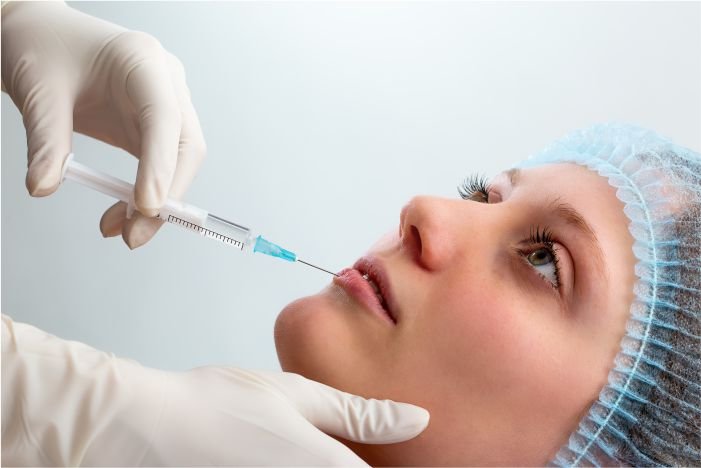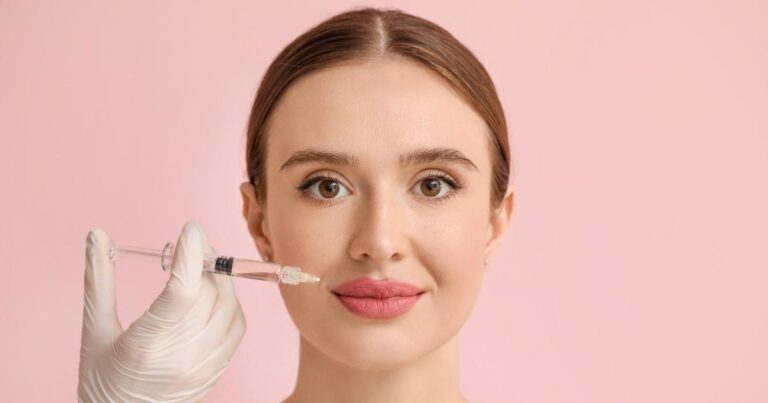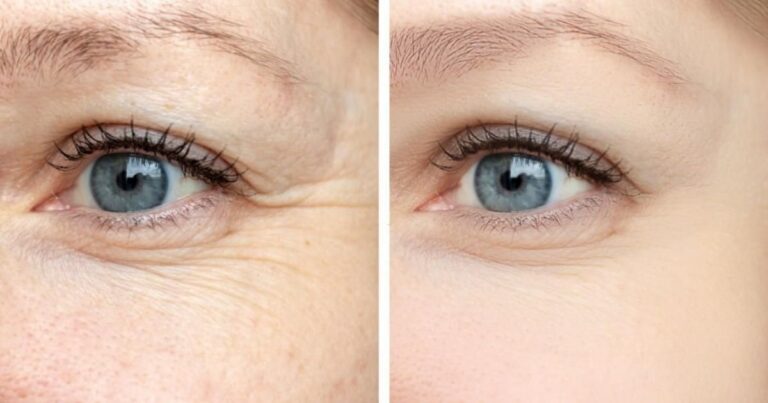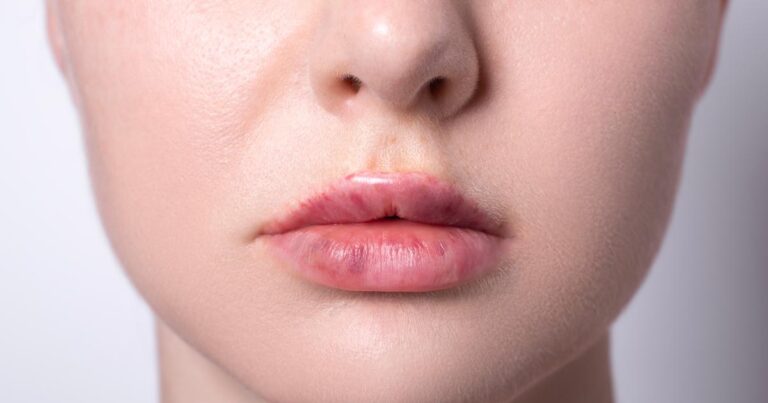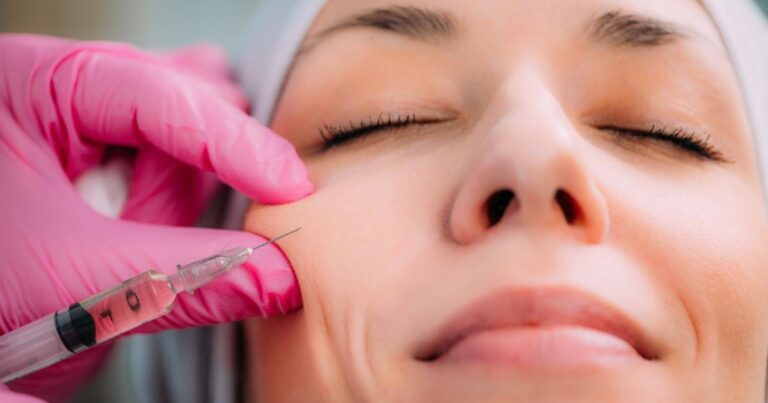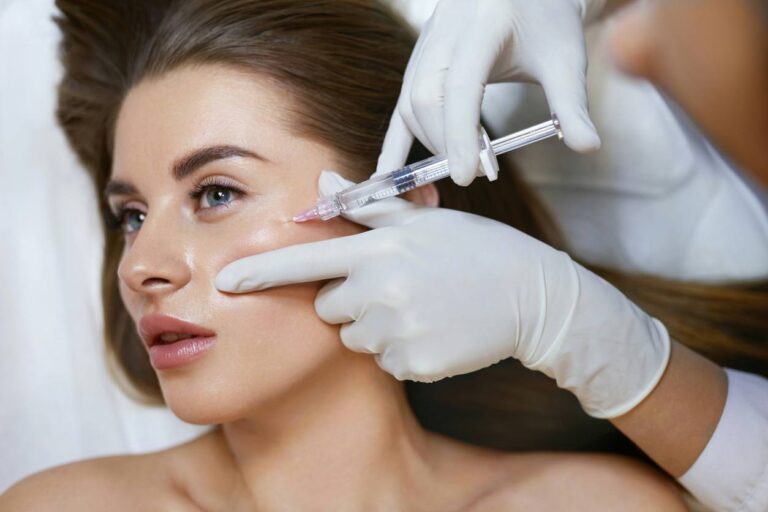Fillers have become an increasingly popular way to combat signs of ageing and enhance youthful appearances. As with any cosmetic procedure, understanding the pros and cons of fillers is important when considering treatment.
This guide covers common types of fillers, their benefits, risks to be aware of, ideal candidates, and what to expect during the filler process.
What are Fillers?
Dermal fillers are substances injected under the skin to restore lost volume, smooth lines and wrinkles, and enhance facial contours. Fillers help counteract signs of ageing like facial hollowness and sagging skin caused by diminishing collagen and elastin levels. They can also accentuate features like lips and cheeks.
There are many types of fillers available today. The most popular injectables are:
Book A Consultation With Dr Tarek Bayazid
Top-rated Plastic Surgeon For Fillers in Dubai
Installment Plan Available
- Hyaluronic acid fillers – Hyaluronic acid (HA) is a naturally occurring substance in the skin that delivers hydration and volume. HA fillers support collagen production for a natural-looking volume that lasts 6-12 months. Popular U.S. FDA-approved HA brands include Juvederm, Restylane and Belotero.
- Calcium hydroxylapatite – This filler contains calcium hydroxyapatite microspheres suspended in gel. It safely rebuilds bony facial structures and lasts up to 18 months. The leading brand is Radiesse.
- Poly-L-lactic acid – Also known as Sculptra Aesthetic, this collagen-stimulating filler helps restore lost facial volume in sunken areas like temples and cheeks over time through a series of treatments. Results may last more than two years.
Fillers Pros/Benefits: Factors To Consider
Injecting dermal fillers comes with many benefits that make them appealing:
Non-Surgical Procedure with Fast Results
Fillers offer the benefits of an anti-ageing treatment without surgery or extensive recovery. Most patients resume normal activities immediately with temporary redness, swelling, or bruising at the injection sites. Visible improvements in wrinkles and volume loss appear quickly.
Enhanced Natural Beauty
In the hands of an experienced injector, fillers beautifully restore youthful fullness and proportion to the face for a refreshed yet natural look. Unlike overfilled or static faces, subtle filler placement complements existing facial features.
Walk-In, Walk-Out Procedure
Filler injection sessions typically take less than an hour from start to finish in an office setting. An experienced injector will listen to your cosmetic goals, determine an optimal filler treatment plan, inject strategically, allow time for the filler to settle, and send you on your way.
Improved Skin Quality
Some fillers like Sculptra boost collagen production for firmer, more toned skin that appears rejuvenated. Consistent HA filler treatment trains skin to make more hyaluronic acid over time. Improved overall skin quality is an added filler benefit.
Non-Permanent Option
While clinical studies show today’s leading fillers provide reliable results lasting from 6 months to 2 years, nothing injected is permanent. Fillers eventually get absorbed and naturally excreted by the body. If, for any reason, someone is not satisfied with their filler treatment, the results will gradually fade until they disappear completely.
Fillers Cons: Risk Factors To Know
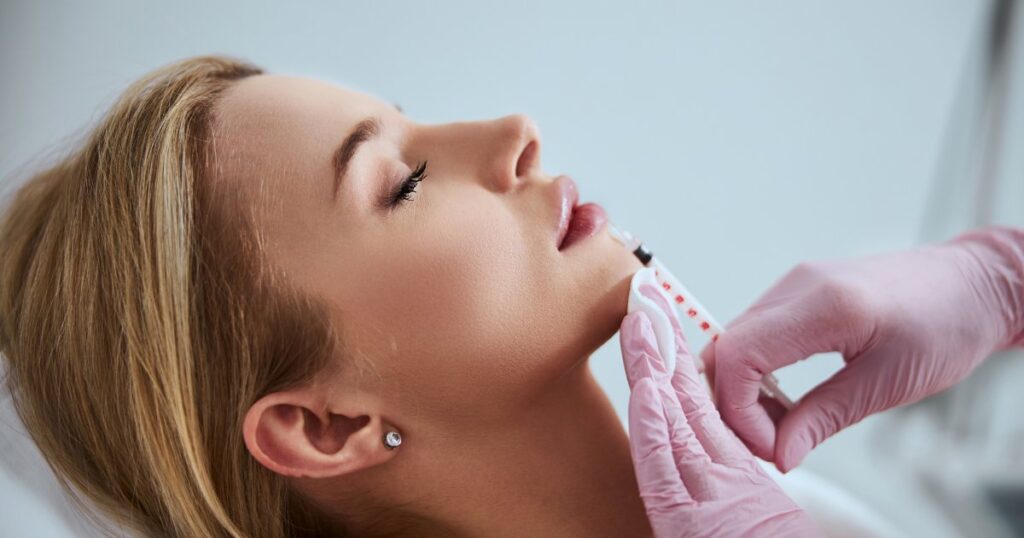
While today’s advanced fillers have excellent safety profiles when injected properly, temporary side effects and rare risk complications can occur:
Injection-Related Reactions
It’s common to experience temporary bruising, tenderness, swelling, numbness, redness, or itching at filler injection sites. Lumps may form under the skin in some cases that can be gently massaged out. Always alert your provider about reactions.
Asymmetry
Unskilled injectors with an untrained eye may incorrectly place fillers, resulting in uneven or imbalanced facial contours. Misplaced filler, which causes asymmetry or anything else unsatisfactory, can be dissolved by injection of hyaluronidase.
Overfilled Look
Too much filler, especially in the lips and lower face, looks unnatural and distorted – sometimes called a “trout pout.” Ensuring a qualified, conservative injector performs treatment prevents overfilling.
Vascular Compromise
In rare cases, fillers inadvertently injected into an underlying blood vessel can decrease or block blood flow, leading to tissue damage and potential vision loss. Seeking emergency care is vital should this extremely rare vascular compromise occur.
Biofilm Formation
For undetermined reasons, in extremely uncommon cases, biofilm can develop as a response to hyaluronic acid filler. Biofilm consists of bacteria embedded in a matrix related to infection, which needs antibiotic treatment.
Who Makes an Ideal Filler Candidate?
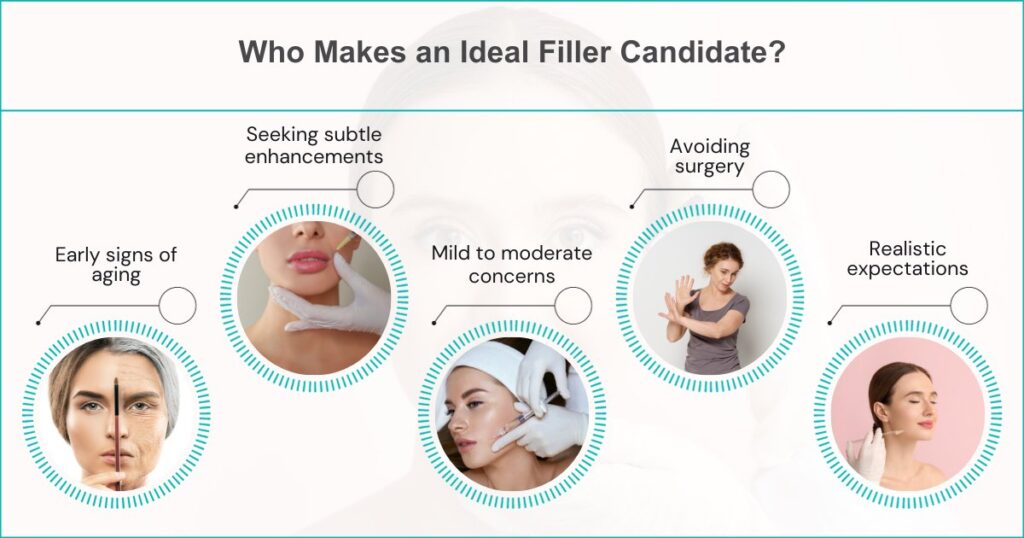
People who are bothered by early signs of facial ageing, like nasolabial folds and volume loss yet not ready for surgery, are prime filler candidates. Those wanting a subtle refreshed appearance or minor cosmetic enhancements to boost confidence also do well with fillers. Ideal candidates include:
- Healthy men and women ages ~25-60
- Individuals are starting to show facial wrinkling and sagging
- Those with mild to moderately deep folds and hollow areas
- People desiring subtle cosmetic improvements without surgery
- Filler veterans who enjoy ongoing maintenance injections
- Candidates with realistic expectations for injectables
Poor candidates are people prone to keloid scarring, patients with current skin disease or infection near injection sites, and those with bleeding disorders or on blood thinners.
What To Expect: The Filler Appointment Process
| Stage | Details | Duration |
| Consultation | – Provider learns about your cosmetic goals and medical history – Discusses best filler options for optimal treatment | 15-20 minutes |
| Numbing | – Topical numbing cream applied – Or injected numbing medication used | 20-30 minutes to take effect |
| Filler Injection | – Thin needles precisely inject filler into target facial areas – Meticulous techniques used for a natural look | 15-30 minutes |
| Massage | – Light pressure was applied to allow the filler to settle – Provider has you sit up to see a refreshed look | 5 minutes |
| Assessment | – Provider examines your subtle enhanced results – Touches up any missed spots for further improvement | 5-10 minutes |
The entire filler appointment process from start to finish usually lasts 60-90 minutes, depending on the extent of treatment areas. Understanding what to expect ahead of time makes the process smooth and comfortable. Let me know if you need any other details added to the table!
Expect some tenderness, swelling, redness, and potentially slight bruising following injections, which typically resolves in a few days. Avoid alcohol consumption or blood thinning medications for 24 hours. Schedule any special events after your filler appointment accordingly. Most patients return for maintenance filler injections around the 6-12 month mark, depending on which type they receive.
Dermal fillers offer a non-surgical, effective solution for restoring lost facial volume, enhancing contours, and smoothing fine lines and wrinkles. When administered by an experienced and reputable injector, fillers can significantly improve signs of ageing, providing natural-looking, beautiful results with minimal downtime.
However, it’s important to consider the pros and cons; while temporary side effects are a possibility, the risks of an overfilled appearance should also be taken into account. Careful consideration of the pros and cons is vital in setting realistic expectations.
Ultimately, educating yourself about the advantages and disadvantages of fillers and selecting an injector who prioritises safety is key to ensuring a positive experience. To determine if fillers may be right for you or learn about additional facial rejuvenation options, contact Dr Tarek Bayazid to book a consultation today.
FAQs: Common Filler Questions
How much do fillers cost?
Average prices per syringe range from 1,800 AED to 4,500 AED depending on type and treatment region.
Which areas can be treated with fillers?
Fillers rejuvenate lips (lip augmentation), nasolabial folds, cheeks, temples, chin, jawline, tear troughs under the eyes, and hands.
Can you receive too many filler injections?
When performed properly at therapeutic levels, there are no known contraindications to ongoing filler maintenance. However, excessive fillers lead to undesirable results. Experienced injectors avoid over-filled appearances.
Are filler results permanent?
No. Depending on the type injected, predictable filler results last from 6 months up to 2 years. The body naturally absorbs non-permanent filler material over time.
Do fillers make you look fake or unnatural?
In skilled hands, fillers restore youthful volume and smooth lines beautifully. A trustworthy injector focuses on safety and natural-looking enhancement.
